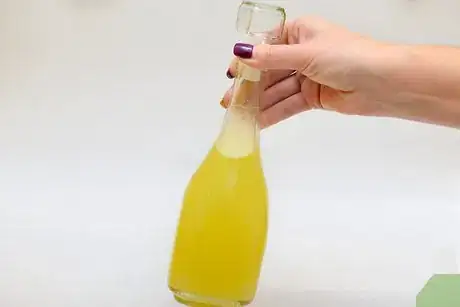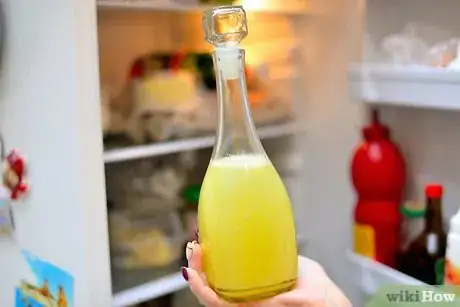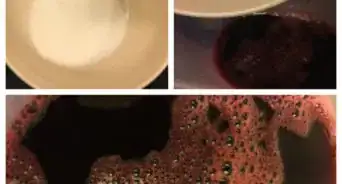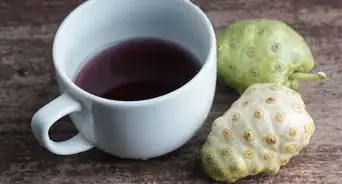This article was co-authored by wikiHow Staff. Our trained team of editors and researchers validate articles for accuracy and comprehensiveness. wikiHow's Content Management Team carefully monitors the work from our editorial staff to ensure that each article is backed by trusted research and meets our high quality standards.
There are 8 references cited in this article, which can be found at the bottom of the page.
This article has been viewed 39,222 times.
Learn more...
Mead is a sweet, honey-based alcoholic drink that comes in a huge variety of different flavors including very sweet, full and rich, and bone dry. Tasting mead involves picking the different flavors that you want to try before taking in the aromas, appearance, and taste of each mead. To serve mead, decide whether to chill the bottle or keep it at room temperature, choose a type of drinking vessel, and pair food with the mead if desired.
Steps
Tasting Mead
-
1Choose the types of mead that you want to try. Mead is the oldest alcoholic drink in the world, and is made from fermented honey and diluted water. It often has fruits, vegetables, grains, or spices added. You can either make your own mead at home, purchase it from a local meadery or liquor store, or go to a tasting session.[1]
- Traditional mead is made just from honey, water, and yeast.[2]
- Bochet mead is made by the honey being caramelized separately before the water is added. This mead has a rich marshmallow or toffee flavor!
- Melomel mead is made using fruit or fruit juices, and sometimes has spices added too.
- Metheglin mead is a mead made with lots of spices. These are usually ginger, orange peel, cinnamon, coriander, nutmeg, tea, or cloves.
-
2Go to a craft mead taproom to try a variety of different meads. There are over 500 meaderies scattered across the US, and many have taprooms which give you the opportunity to taste many different types of mead in one sitting. Mead is also widely available in the UK and Europe. Contact your local meadery ahead of time to arrange a tasting.[3]
- In the US, Maryland, Oregon, New Hampshire, Illinois, New York, and Arizona are all popular mead distributors.
- Some European countries such as Poland even have vacations based around mead, where you can taste many different samples and learn how to make your own.[4]
Advertisement -
3Smell the mead immediately after it has been poured. Keep the glass still, place your nose just above the glass, and inhale deeply. Consider how many different aromas you can smell, and the tones that the mead has (such as fruity, woody, or floral).
- Make sure that you don’t have a cold or have just eaten a spicy meal, as this will affect your sense of smell.
-
4Look at the glass of mead against a white background. Tilt the glass slightly to take in the color of the mead. Look straight down at the mead from above to see the intensity of the color.
- The color depends on the type of mead that you are tasting, and what sort of honey and fruits have been used.
- It’s common for the color to vary slightly from the edges of the glass to the center.
-
5Taste a small amount of mead and let it run over your whole tongue. Swirl the mead slightly to aerate it, and take a small sip from the glass. Make sure that the mead comes in contact with the whole of your tongue before swallowing.
- Determine the blend of fruits and spices that you think have been used in the mead.
-
6Evaluate the aftertaste of the mead. Let the flavor linger in your mouth, and see what tones you can detect. The mead may taste different when you have swallowed it compared to your first sip.[5]
- Decide what you thought of the taste of the mead, including your first impression, if you liked it or not, and if it matched what you thought the taste would be based on the smell and appearance.
Serving Mead
-
1Serve mead either at room temperature or slightly chilled. Although mead can be enjoyed hot or cold, most people today enjoy mead slightly chilled. Check the label, or ask at the meadery what the best temperature is to serve your mead.
- If you are unsure about whether to chill your mead or keep it at room temperature, try it both ways! Experiment with how the temperature adjusts the flavor of the mead.
- Generally, sweeter meads are chilled to 10–12 °C (50–54 °F).
-
2Pick a glass that is 8–10 fl oz (240–300 ml) to drink mead the modern way. Mead is often drunk from glass or crystal vessels that are egg-shaped, have a stem, and are colorless. Mead glasses also have thin walls and are fully transparent, with no drawings or designs on the glass.
- Using this specific type of glass will ensure that you get the best taste possible from your mead, as it will concentrate the aromas.
- Mead glassware is very similar to wine glassware.
- You can purchase mead glasses from specialty homeware stores or online.
-
3Drink mead from a horn, tankard, or mazer to have a traditional experience. Mead has existed for much longer than glass, which means that to get a traditional mead experience you will need to use a different kind of vessel. You can buy traditional mead drinking vessels online.[6]
- Mead horns are shaped similarly to bovine horns, as mead was originally served in cattle horns.
- Tankards are ale cups that are made from wood, pewter, or horn.
- Mazers are soup-bowl sized drinking vessels that are made from wood or metal. A traditional friendship and welcoming ceremony is still performed in some areas of Scotland, where two people symbolically drink mead from the same cup.
-
4Pair dry mead with dinner. Heavier, savoury foods go well with drier types of mead. Spiced or dark and fruity meads pair best with darker foods, such as steaks, barbeques, and stews.[7]
- Melomel mead that is made with dark berries or cherries pairs especially well with dark meats.
- For lighter meat such as chicken or fish, light, dry meads are best.
-
5Drink sweeter mead with dessert. Lighter, fruity meads pair best with sweeter foods. Sweet mead can also be enjoyed alone as a summer refreshment.[8]
- Sparkling mead is also good as a palate cleanser in between courses.
-
6Store leftover mead in a cool, dark place for 3-6 months. Room temperature is ideal for storing opened mead, as storing an open bottle in the fridge will affect the fermentation process and shorten the lifespan. Unopened mead can be stored for up to 5 years.[9]
- Check the label on the mead for an indication on how long that particular bottle will last.
- Don't freeze mead, as this will affect its flavor.
- You can tell when mead has gone bad because it will have a rancid aroma, and it will taste bitter.
Warnings
- If the mead has a vinegar-like smell, don’t drink it as it won’t be safe to drink.⧼thumbs_response⧽
- If you are tasting mead outside your own home, always designate a sober driver first or call a taxi so that you can drink responsibly.⧼thumbs_response⧽
References
- ↑ https://www.seriouseats.com/2014/07/what-is-mead-how-is-mead-made-best-bottles.html
- ↑ https://healthywithhoney.com/types-of-mead/
- ↑ https://www.foodandwine.com/cocktails-spirits/craft-mead-taprooms
- ↑ http://www.stormthecastle.com/mead/articles/mead-making-vacation-in-poland.htm
- ↑ https://www.cawineclub.com/wine-tasting-terms
- ↑ https://www.meadmakr.com/mead-drinking-vessels/
- ↑ https://www.hiddenlegendwinery.com/what-food-goes-with-mead/
- ↑ https://www.hiddenlegendwinery.com/what-food-goes-with-mead/
- ↑ https://www.doesitgobad.com/does-mead-go-bad/



































































